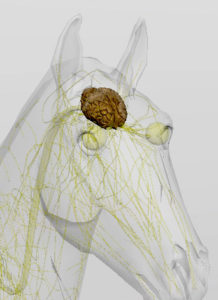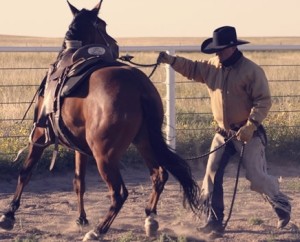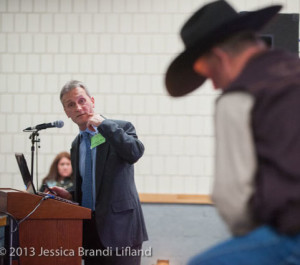How to build self-confidence in a horse?
It’s a concept to be discussed at next month’s Evidence-Based Horsemanship Seminar, led by Martin Black and Dr. Steve Peters.
 Peters said giving horses repeated exposure to novel experiences is a great way to down-regulate their fear component and nurture what we call confidence.
Peters said giving horses repeated exposure to novel experiences is a great way to down-regulate their fear component and nurture what we call confidence.
Here’s what a horse challenge (jumping a log, crossing a creek, loading into a strange trailer, learning the feel of spurs) might look like on the neurological level:
Sensations or neural inputs travel up to the thalamus, a part of the brain that’s like a telephone switchboard, routing nerve messages. If you’ve presented the experience in a positive manner, the horse’s reaction will be one of curiosity but not fear. It will likely proceed with your request. The neural message will head from the thalamus to the motor strip, a section of the horse’s brain dedicated to movement.
However, if the sensation is accompanied by pain or fear, the route from the thalamus will lead to the hypothalamic pituitary, adrenal (HPA) axis, the body’s central response system to psychological or physical stress.
“You never want responses to be routed to that pathway,” said Peters. The more consistently you can run sensations through the thalamus and toward where they need to go (usually the motor strip), rather than towards a stress-related response, the better off you’ll be.”
When the horse is able to predict this positive outcome, despite the novelty of each experience, it becomes more confident.
Confidence is not to be confused with trust and joining up. As in, “He’ll go anywhere with me. That’s how much he trusts me.”
When working with a horse, we do not want a horse that relies on our leadership in a toddler-ish, hand-holding manner. Teaching a horse to stick with us like that, says Black, can perpetuate a needy dependency. Women, especially, are prone to nurturing a warm and fuzzy relationship in which the horse does indeed stick with us, he said. But when things get dicey (a horn blares, a ceiling falls, a door slams), the horse will look to the rider as  an island of safety and it will want to be ON that island (when the rider is on the ground).
an island of safety and it will want to be ON that island (when the rider is on the ground).
“I see it all the time. Students have developed a “trusting” relationship, but then are run over by their horses. It’s dangerous,” said Black.
“The self confidence I am talking about is when they are very sure of their decision making and their ability to judge and handle difficult situations. This comes from giving them experience in difficult situations, giving them choices, and helping them learn the avenues to success. If they run into more discomfort with the wrong choices, then they learn to make the right decisions without us nurturing them to the right answer.”

Are horses capable of “decision making” and ” judgment” ? I was taught that the way their brain is made up its only wired for reactions.
Interested to know
Thanks
K.Dawn
Kristi, Horses certainly ARE capable of making decisions and judgments. They do so constantly when they chose paths to take, objects to avoid, what to eat, who to hang out with, etc. Horses do not necessarily have brain capacity for things like strategy, goals, and agendas. That’s frontal lobe stuff — more human capacities. Thanks for your interest.
Good article. Nice to read something written with common sense. We want the horse to respond, not react.
K. Dawn, without judgement and decision making skills, how would horses survive? They are also strongly emotional and pick up the emotion of herd mates or a person they know in a nanosecond.
Really disappointed that a site that purports to be about evidence based horsemanship makes a really stereotypical and unsubstantiated comment about the relationship between women and their horses.
Vicki,
Thanks for your comment. While it may be considered stereotypical, Mr. Black and many other interviewed clinicians have repeatedly substantiated this problematic behavior among women riders, especially (again, according to clinicians) on the East Coast where many women prefer to focus on the horse-human relationship and fail to understand the livestock-related and prey behaviors of their partner.
It was an observation made that more women than men tend to foster that style of relationship. I didn’t take it as sexist comment, as what I believe your point was.
I am a women, and I also have seen this type of relationship more in women than men. It is an observation that holds true in my experience.
Interesting, I’ve seen this behavior more so in men and not in a small way either. They treat their horses and dogs the same : and both are poorly mannered.
As a photographer who has been in arenas taking thousands of pictures at clinics all over the US and other countries, I agree that women, way more than men, do indeed get themselves into a “nurturing” relationship with horses that inadvertently fosters dangerous behavior.
And where is Learning Science and Behavior Science in this? It’s nowhere to be found.
All animals learn through Operant Conditioning/Learning. And several studies have shown that positive reinforcement is a better, more humane way to train animals, horses included.
I’m very disappointed in this article, especially as it purports to be “evidence based”. How about scientifically based and moving away from punishment and negative reinforcement (pressure/release).
Zoos, aquariums, and dog trainers have moved on. Why not horse trainers? I know several R+ horse trainers including Peggy Hogan, Alexandra Kurland and others who are very successful at getting what they want through R+ training.
Do the research; get educated.
Negative reinforcement does not mean punishment if correctly defined. “In negative reinforcement, a response or behavior is strengthened by stopping or removing a stimulus”. The term was not coined to indicate punishment. Horses in herds use negative reinforcement to keep things running smoothly. If one horse pins her ears and another horse moves, that’s negative reinforcement. She removes the stimulus when the other horse moves. In a herd environment there isn’t much positive reinforcement being handed out in the form of rewards. I’m not saying positive reinforcement, in my opinion, is not helpful, but it’s not helpful to define negative reinforcement incorrectly.
excellent reply.
Jah- Laurie Higgins said move away from “punishment and negative reinforcement”. Nowhere did she say negative reinforcement *was* punishment. The problem with negative reinforcement is that it stimulates the areas of the brain, engages the pathways that Mr. Black is saying not to stimulate. A release is not a reward. It is a release from pressure, pressure is an aversive. Using aversives (pain and fear) to attempt to build confidence is counter productive, which is what Mr Black is saying.
I would have thought the women doing positive reinforcement had a better relationship with their horses than some macho men using dominance.
It is true we don’t want to stimulate a stress response thus triggering a cartecholamine response which may in turn lead to the HPA axis being stimulated.
I do hope positve reinoforcement is taught correctly and the use of sysematic desensitisation and counter conditioning. Using classical conditioning we can introduce novel objects and have a horse who is not afraid of either his trainer or his surroundings.
If we use only negative reinforcment and positive puishment we risk having a horse who suppresses his reactions for fear of the addition of the aversive stimuli which is then removed (the -R). So the horse learns to avoid the aversive stimuli used to form a behaviour but the underlying fear may never disappear.
This leads to stress and the possiblity of the HPA axis being stimulated. This is especailly common in the use of excessive and escalating negative reinforcment.
To say “all animals learn through operant conditioning” is hilarious. It doesn’t show your intelligence as much as your linear, narrow minded approach. Please let the horse be a horse! Get outside your learning box!
Mary I don’t think you understand what operant conditioning is. “Let a horse be a horse” doesn’t make any sense. What are you trying to say, exactly?
The article talks about the goal of having the horse learn positively in order to build confidence. There’s some brain science information that sounds interesting. So far so good. Then the article goes down a side street where it alleges that women develop warm & fuzzy relationships that make their horses afraid instead of confident. I don’t get it. I can’t imagine that the horses avoid getting on top of the men because they feel so confident. I think it’s more likely that they are thinking, “Whatever else happens, I know it will be worse if I get in this guy’s space!”
Like · Reply · 1 · 7 mins
In reply to Meaghan – let a horse be a horse is another way of saying let’s not impose the very linear learning of humans on horses. Operant conditioning and all other schools are humans’ way of imposing their ideas on something that is NOT in a box, NOT in a book, etc. It’s like weathermen trying to predict weather. We should strive to be students of the HORSE, not students of learning behavior or what have you. As for the negative comments on negative reinforcement, PLEASE read this: http://besthorsepractices.com/when-being-negative-is-a-good-thing/
Horses learn via operant conditioning like all animals do, including humans. I don’t believe you understand what operant conditioning is either. You say, be a student of the horse, like horses somehow learn differently than all other species? In fact, you use operant conditioning and classical conditioning every single time you interact with your horse, including using negative reinforcement, which is one of the four quadrants of operant conditioning. Did you think Natural Horsemanship isn’t operant conditioning? Surprise! It is.
Meaghan, Thanks for challenging me to be more articulate. I will try again: as Dr. Temple Grandin and Dr. Steve Peters have both understood, theories and principles (including all matters of operant conditioning) are like boxes in which us humans like to place horse behavior in order to better understand and simplify what we see and how we interact. However, as I have seen many times with students of these ideas, they cannot completely explain what happens always in horsemanship. If you limit yourself to operant conditioning as some point you will have to be shoving a square peg into a round hole because it simply won’t be able to explain everything you’re seeing or solve every problem. By limiting yourself to these schools, you’re wearing blinders. An evidence-based model is a huge umbrella that includes operant conditioning AND neuroscience AND decades long experience and observation AND may, in the future include other avenues. It is in my mind much more helpful, appropriate, and flexible for horse work.